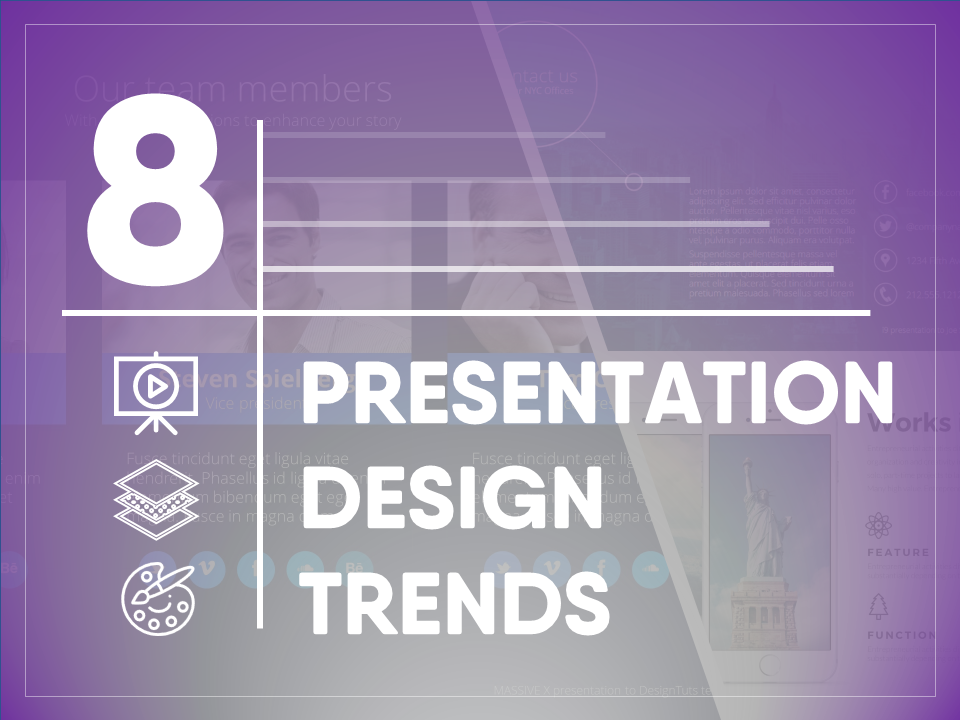by Adam Noar

Presentation design is
half art and half science.
While a strong understanding of PowerPoint
is key to keep things running, it’s the visual embellishments that really make
a PowerPoint presentation memorable.
Just like any science,
presentation designers (professional or otherwise!) must remain agile and move
with new innovations in slide design. But just like any artist, it’s their
prerogative to accept or reject trends based on whether they suit their own
taste and needs.
Many presentation
design trends have come and gone over the years. However, there are a
handful of visual trends we’re confident are here to stay.
More than just a
passing fad, these visual elements elevate your PowerPoint design and leave a
lasting impression on your audience. To help inspire your next slide deck, here
are 8 presentation design trends that you can easily start applying.
1. Clean and minimalist
layouts
They say ‘less is
more’ and this certainly rings true for slide design. Cluttered, chaotic slide layouts
can dilute your brand message and confuse and overwhelm your audience. On the
other hand, a simple and minimalistic layout allows you to draw attention to
only the most important elements on your slide—which is generally your calls-to-action.
What’s more, a clean,
sleek layout never really goes outdated. This means it will be just as
effective a few years down the track as it is now.
Of course, embracing
minimalism on your presentation doesn’t necessarily have to mean using only
black and white. For your purposes, it could mean limiting your palette to just
two or three colors or avoiding large chunks of text on your slides. It’s all
about being deliberate in your presentation design choices and only using
elements that serve a very specific purpose.
2. Dynamic video
backgrounds
Video has come a long
way with presentations.
Now, moving visuals
are everywhere—from our social media feeds and music streaming apps to even ads
on train platforms! Video has also become increasingly popular in presentation
design too and for good reason. Using a full-page video background is an
excellent visual storytelling tool. It immediately piques the user’s interest
and draws them into the narrative of your brand.
There are many
different ways you can incorporate video into your presentations. It can be
used as a kind of dynamic slideshow. This can be an excellent choice for
companies that want to show off multiple selling points for one thing in an
easily digestible format.
Video can also be used
to show atmosphere (for example, of a destination, a workout class or cafe) or
to show a product in action.
While the application
of video will no doubt continue to evolve, one thing is for sure—it’s not going
anywhere. By getting on the video bandwagon now, you can ensure you stand out
and creates a long-lasting impression on your audience.
3. Animated elements
Integrated animations are a great way to give your slides a more interactive experience.
Animation can be incorporated into your slides in many different ways. Some savvy presenters opt to use animated ‘character’ illustrations to draw users into the story of the presentation, or show how their products work. Others use particle backgrounds to add motion to their slides in a visually appealing way.
4. Modular Design
While modern presentation design is all about thinking outside the box, sometimes it’s okay to stay within its confines—literally! Otherwise known as modular design, the uses of boxes in to logically organize content has become a mainstay in presentations.
On an aesthetic level,
this visual trend is great for adding symmetry to your PowerPoint slides. It’s
also particularly helpful for allowing audience members to easily compare and
take in information at a glance. Accompanied by icons, the designer has used
boxes to nearly communicate the various services her agency offers.
Modular design is also
excellent for comparing a product with a competitor or laying out different
price packages and options.
5. Gradients
Once a staple of 90s
corporate design, colorful gradients made a comeback in 2018 and it looks like
they’re here to stay! Put simply, gradients are the gradual transition from one
color to another, creating a blended effect. So, what makes them so “slidetastic”
(yes, I just invented that word!)? Firstly, they add a vibrant pop of color to
your presentation in a way that doesn’t feel overpowering. They’re also a great
way to add extra visual depth to your slide design, as they create a dynamic,
almost multi-dimensional effect.
The beauty of this presentation
design trend is how versatile it is. You can create gradients using similar
colors such as blue or yellow, or create unexpected combinations using
contrasting shades like purple and orange. You can reduce the opacity for a
more muted effect, or use it at full intensity. You can also use it as a
standalone element, or as an overlay on photo.
6. Illustrations
Whether it’s
three-dimensional cartoons, abstract shapes or animated graphics, illustrations
are a fantastic alternative to static imagery on presentations. Firstly, as
they’re less overused than stock imagery, they help set your brand apart from
the masses. They’re also great for helping you explain abstract concepts, as
they can be used in step-by-step diagrams or infographics.
Illustrations are also helpful for giving your brand a more personalized, ‘human’ feel without relying on stock photos or photoshoots. These illustrations a creative way to show—not tell—employees engaging with the platform, as well as communicating their brand value of diversity.
You don’t need to be a
professional illustrator to use these eye-catching graphic elements in your presentation.
Platforms like Freepik have a library of
illustrations you can easily add into your own creations.
7. The use of white
space
Sometimes, great design is as much about what you don’t include as what you do. This is why white space is one design trend that will never become obsolete. Otherwise known as negative space, white space is any empty or unused space on your slide.
Incorporating these blank spaces into your presentation helps to create a tidy and visually appealing slide. Your audience will feel they have room to breathe, as they aren’t being bombarded with too much visual and text. It’s also an indispensable tool for creating a seamless user experience as they move from one slide to the next. It helps to direct the user’s attention to where you want it to go and makes them more likely to absorb and recall the key information.
Your background
doesn’t necessarily need to be white to use ‘white space’ in your website
designs. However, a plain white background can be a great place to start when
it comes to creating that crisp, airy feel on your slide.
8. Bold typography
While the background, images and colors set the scene of your presentation design, it’s the typography that does the talking.
When perfectly
synchronized with the written content of your slide, it’s where your brand
voice can really shine through. While brush scripts and handwritten fonts that
have been the fonts du jour in web design in recent years, it’s uncertain
whether these trends will stick around. But if you’re looking to create an
expressive presentation that never goes out of style, you can’t go past big and
bold typefaces.
Whether it’s a sleek san-serif or chunky capitalized text, dramatic fonts are hard to ignore.
Conclusion
While many presentation design trends come and go, these classic elements will stay relevant for a long time to come! By putting your own unique spin on them, you can create a presentation that stands out against the crowd and stands the test of time!

Looking For Powerpoint Design Agency?
Call Pursho @ 0731-6725516
Telegram Group One Must Follow :
For Startups: https://t.me/daily_business_reads
#Presentation #Design #Trends #Captivate #Audience




